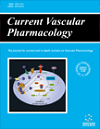- Home
- A-Z Publications
- Current Vascular Pharmacology
- Previous Issues
- Volume 18, Issue 3, 2020
Current Vascular Pharmacology - Volume 18, Issue 3, 2020
Volume 18, Issue 3, 2020
-
-
Pathophysiology of Thrombosis in Peripheral Artery Disease
More LessAuthors: Aida Habib, Giovanna Petrucci and Bianca RoccaUnder physiological conditions, peripheral arteries release endogenous vascular-protective and antithrombotic agents. Endothelial cells actively synthesize vasoactive mediators, which regulate vascular tone and platelet reactivity thus preventing thrombosis. Atherosclerosis disrupts homeostasis and favours thrombosis by triggering pro-thrombotic responses in the vessels, platelet activation, aggregation as well as va Read More
-
-
-
Antithrombotic Therapy in Lower Extremity Artery Disease
More LessAuthors: Mislav Vrsalovic and Victor AboyansLower extremity artery disease (LEAD) is a marker of a more advanced atherosclerotic process often affecting multiple vascular beds beyond the lower limbs, with a consequent increased risk for all-cause and cardiovascular mortality. Antithrombotic therapy is the cornerstone of management of these patients to prevent ischaemic cardiovascular and limb events and death. In patients with symptomatic LEAD, the efficacy of asp Read More
-
-
-
Antithrombotic Therapy for Peripheral Revascularisation
More LessAuthors: Marco De Carlo, Marco Angelillis and Riccardo LigaLower extremity artery disease (LEAD) represents a major public health burden, affecting hundreds of millions of people worldwide. Although risk-factor modification, exercise training and medical treatment are the mainstays of the management of LEAD, endovascular or surgical revascularisation is recommended when there is the risk of limb amputation and when drug-resistant claudication severely affects patie Read More
-
-
-
The Bleeding Risk in Antithrombotic Therapies: A Narrative Review
More LessAuthors: Adriano Alatri and Lucia MazzolaiBleeding represents the most important complication of antithrombotic treatment, including anticoagulant and antiplatelet therapies. A number of scores were proposed to evaluate the risk of bleeding both for anticoagulant and antiplatelet treatment. In the last decade, 5 bleeding risk scores were published for use in atrial fibrillation patients, and 3 scores for patients receiving anticoagulants for venous thromboembolism ther Read More
-
-
-
Hypertriglyceridemia: An Infrequent, Difficult-to-predict, Severe Metabolic and Vascular Problem Associated with Estrogen Administration
More LessSupplementary estrogen plays important roles for female patients as convenient birth control, relief of postmenopausal symptoms, and in the management of other selected problems. However, as is the case for essentially all medications, there are side effects. Short of a major pulmonary embolus, the most severe side effect of estrogen would appear to be sporadic, rare, and severe hypertriglyceridemia associated with ac Read More
-
-
-
Antiplatelet Therapy in Acute Coronary Syndromes. Lights and Shadows of Platelet Function Tests to Guide the Best Therapeutic Approach
More LessAuthors: Giovanni Cimmino, Emanuele Gallinoro, Luigi Di Serafino, Nicola De Luca and Plinio CirilloThe key role of platelets in pathophysiology of Acute Coronary Syndromes (ACS) has been well recognized. Platelet activation and aggregation, together with tissue factor-pathway activation, lead to acute thrombus formation in the coronary vessels at sites of plaque rupture. Thus, antiplatelet therapy with drugs able to interfere with platelet activation/aggregation represents a cornerstone of ACS treatment in intens Read More
-
-
-
Metabolic Complications and Kidney Transplantation: Focus on Glycaemia and Dyslipidaemia
More LessPost-transplant diabetes mellitus (PTDM) and dyslipidaemia are the most common metabolic complications in kidney transplant recipients (KTR). They are associated with a higher risk of lower graft function and survival, as well as an increased risk of cardiovascular disease (CVD). The aim of this review is to provide current data on the epidemiology, pathophysiology and optimal management of these two principal metabolic c Read More
-
-
-
Management and Outcomes of Aortic Dissection in Pregnancy with Marfan Syndrome: A Systematic Review
More LessAuthors: Hassan Al-Thani, Ahammed Mekkodathil and Ayman El-MenyarBackground: In Marfan Syndrome (MFS), aortic dilatation is one of the main cardiovascular manifestations which deteriorate due to the physiological changes during pregnancy. We aimed to assess the up-to-date management and outcomes of aortic root dilation and dissection (AoD) in pregnancy with MFS. Patients and Methods: A systematic review was conducted and reported according to the Preferred Reporting Ite Read More
-
-
-
Improving Adherence to Ticagrelor in Patients After Acute Coronary Syndrome: Results from the PROGRESS Trial
More LessBackground: Dual antiplatelet therapy (DAPT) with aspirin and ticagrelor is recommended for at least 12 months in patients after an acute coronary syndrome (ACS). However, its underuse and premature discontinuation are common in clinical practice. We aimed to investigate the impact of a dedicated follow-up strategy with clinical visits and counselling on adherence levels to ticagrelor in patients after ACS. Methods: PROGRE Read More
-
Volumes & issues
-
Volume 23 (2025)
-
Volume 22 (2024)
-
Volume 21 (2023)
-
Volume 20 (2022)
-
Volume 19 (2021)
-
Volume 18 (2020)
-
Volume 17 (2019)
-
Volume 16 (2018)
-
Volume 15 (2017)
-
Volume 14 (2016)
-
Volume 13 (2015)
-
Volume 12 (2014)
-
Volume 11 (2013)
-
Volume 10 (2012)
-
Volume 9 (2011)
-
Volume 8 (2010)
-
Volume 7 (2009)
-
Volume 6 (2008)
-
Volume 5 (2007)
-
Volume 4 (2006)
-
Volume 3 (2005)
-
Volume 2 (2004)
-
Volume 1 (2003)
Most Read This Month
Article
content/journals/cvp
Journal
10
5
false
en


